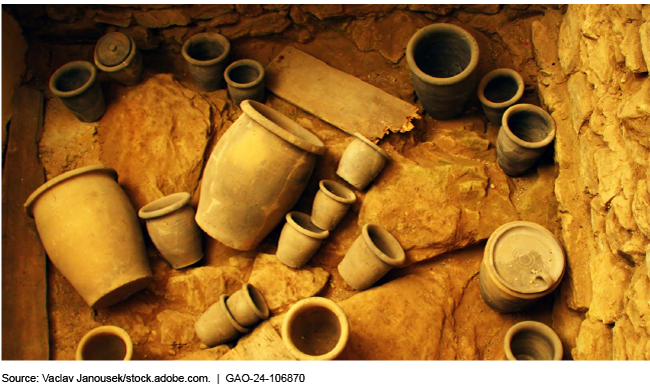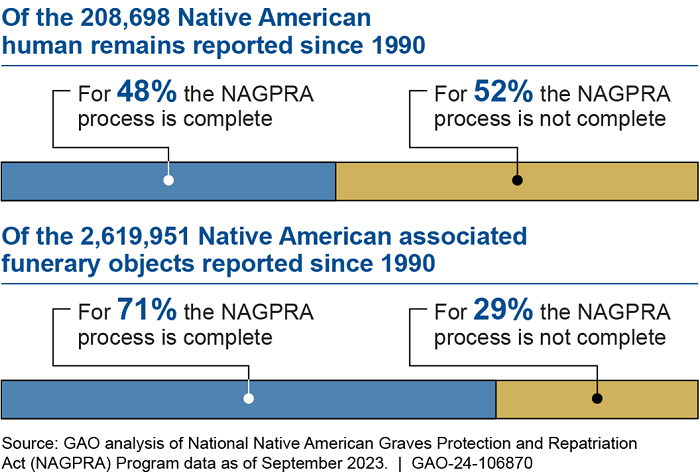Native American Priorities: Protection and Repatriation of Human Remains and Other Cultural Items
Fast Facts
The Native American Graves Protection and Repatriation Act requires federal agencies and specific museums to return certain Native American human remains and other cultural items. Agencies have made some progress since the 1990 act, but hundreds of thousands of human remains and other cultural items have yet to be repatriated.
In this Snapshot report, we look at how our past work could help agencies implement and enforce the act.
For example, we've made recommendations on improving federal agencies' communication with tribes—which could help in the process of identifying items to be repatriated.

Highlights
More than 30 years have passed since the enactment of the Native American Graves Protection and Repatriation Act (NAGPRA), which requires federal agencies and specific museums to repatriate certain Native American human remains and other cultural items. Agencies have made some progress implementing NAGPRA, but hundreds of thousands of Native American human remains and other cultural items have yet to be repatriated. Addressing our prior recommendations will help agencies confront challenges they face with implementing and enforcing the act.
The Big Picture
Native Americans may consider certain cultural items sacred or significant and the damage or theft of these items to be detrimental to preserving their culture and traditions. NAGPRA seeks to repatriate specific Native American cultural items—including human remains, funerary objects, sacred objects, and objects of cultural patrimony—by requiring federal agencies and museums to (1) identify cultural items in their possession or control; (2) identify, where possible, the cultural affiliation between those items and a present-day Indian tribe or Native Hawaiian organization; and (3) generally repatriate culturally affiliated items upon request to lineal descendants, Indian tribes, and Native Hawaiian organizations under the terms prescribed in the act (see Legal Terms).
Since NAGPRA was enacted in 1990, federal agencies and museums have reported being in possession of almost 3 million Native American human remains and associated funerary objects, according to the Department of the Interior's National NAGPRA Program. The program's 2022 report notes that these agencies and museums have not completed the NAGPRA regulatory process for 52 percent of human remains and 29 percent of associated funerary objects. For those cultural items, the process is complete when any necessary tribal consultation for possible cultural and geographical affiliation is concluded and the human remains or associated funerary objects have been listed in a completed inventory published in the Federal Register, according to a program official. Until the process is complete, the items are not available for repatriation (see figure).
Status of Certain Native American Cultural Items Reported by Federal Agencies and Museums under NAGPRA

NAGPRA also prohibits the intentional removal or excavation of Native American cultural items from federal and tribal lands unless certain conditions are met, including consultation with and—in the case of tribal land—consent from the appropriate Indian tribe or Native Hawaiian organization. Further, NAGPRA criminalizes the knowing sale, purchase, use for profit, and transport for sale or profit of Native American cultural items obtained in violation of the act, among other actions.
What GAO’s Work Shows
Our prior work shows that federal agencies have made progress in implementing NAGPRA. However, the progress has taken decades and, as we reported in 2022, challenges remain.
NAGPRA Implementation and Tribal Consultation
NAGPRA and its implementing regulations require federal agencies to consult with lineal descendants, Indian tribes, and Native Hawaiian organizations, as appropriate, in connection with the identification, affiliation, and repatriation of Native American cultural items, as well as when such items are inadvertently discovered on federal lands. Tribes and tribal organizations have expressed concerns about how some agencies are implementing NAGPRA’s consultation requirements. We previously recommended that federal agencies take steps to improve tribal consultation processes in other contexts. Failure to consult with Tribes, or to consult effectively, may result in irrevocable damage to cultural resources.
NAGPRA Enforcement and Protections of Native American Cultural Items
NAGPRA prohibits the removal of Native American cultural items from federal and tribal lands, except in certain circumstances. Federal agencies have taken a number of approaches to prevent and detect theft of and damage to Native American cultural items. But resource constraints, competing priorities, and limitations with data to support decision-making have hampered agencies’ efforts to prevent, investigate, and prosecute incidents of theft and damage.
Limitations in the legal prohibitions on theft and trafficking of Native American cultural items have posed another challenge. Congress took steps to address some of those limitations when it passed the Safeguard Tribal Objects of Patrimony Act of 2021 (STOP Act), which became law in 2022 and aims in part to prevent the international export of cultural items prohibited from trafficking under NAGPRA and other laws. Interior is currently developing regulations and taking other actions to implement the STOP Act.
Challenges and Opportunities
While federal agencies have made some progress, such as making annual data on the status of federal agencies’ repatriation progress readily available, challenges remain with implementing and enforcing NAGPRA. In particular, more work is needed to repatriate the hundreds of thousands of Native American cultural items that are still in the possession of federal agencies and museums. In October 2022, Interior proposed revisions to its NAGPRA regulations that, according to the agency, are designed to streamline and improve its regulatory process. However, Interior has yet to finalize these regulations. Additionally, the challenges we have identified and our prior recommendations underscore the importance of further examining how federal agencies are implementing and enforcing NAGPRA. We can analyze these and other challenges and opportunities in our future work on cultural protection to support Congressional oversight of NAGPRA implementation and enforcement.
In our 2010, 2018, 2019, and 2021 reports, we made a total of 55 recommendations related to the protection of Native American cultural items and tribal consultation. As of September 2023, federal agencies had fully implemented 47 of these recommendations. Implementing the remaining eight could help Interior target efforts to analyze and address risks to Native American cultural resources and improve how federal agencies communicate with Tribes that request assistance with repatriating cultural items from overseas auctions. This could also improve agencies’ efforts to consult with Tribes on certain federal efforts that could affect cultural resources.
Legal Terms
Under NAGPRA (Pub. L. No. 101-601, as amended), a museum is any institution or state or local agency that receives federal funds and has possession or control of Native American cultural items, which include human remains, funerary objects, sacred objects, and objects of cultural patrimony. NAGPRA defines other key terms, including federal lands, Indian tribe, Native American, Native Hawaiian organization, and tribal land. 25 U.S.C. § 3001. Our use of terms is in keeping with NAGPRA’s definitions.
For more information about this Snapshot, contact: Anna Maria Ortiz, Director, Natural Resources and Environment, (202) 512-3841.
